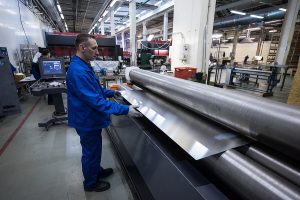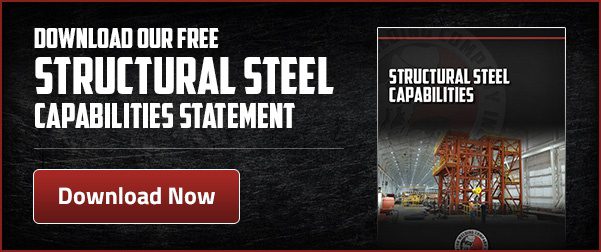Precision Rolling and Forming: How In-House Capabilities Improve Quality and Cut Lead Times
In industrial fabrication, few things slow a project down like fit-up problems. Whether it’s a misaligned cylinder, an uneven seam, or a cone that’s just slightly out of round, poorly rolled components can bring assembly to a halt. That downtime doesn’t just cost money; it strains schedules, creates safety concerns, and adds layers of unnecessary rework.
Much of this stems from one issue: inconsistent rolling and forming. When shops outsource these key steps to third-party vendors or rely on outdated equipment, they introduce risk at the very beginning of the fabrication process. It’s a gamble that Swanton Welding refuses to take.
By keeping rolling and forming in-house and investing in the right machinery, personnel, and quality control, Swanton Welding delivers dependable components that fit right the first time. This tight control over the process means faster turnarounds, tighter tolerances, and ultimately better outcomes for every customer they work with.
Why Rolling and Forming Matter So Much
Rolling and forming are often early steps in producing structural components like tanks, ductwork, cones, hoppers, and enclosures. These shapes must be precise because every degree of bend or millimeter of deviation affects how parts come together later.
When a rolled shell is out of spec, even by a small margin, downstream problems are guaranteed to follow. Weld seams don’t align. Flanges don’t match up. Installation gets delayed. In some cases, improperly rolled parts can compromise structural integrity, particularly in applications where pressure, vibration, or load-bearing is involved.
For contractors, OEMs, and engineers working on complex systems, this level of unpredictability is unacceptable. They need components they can trust, rolled and formed to spec, delivered on time, and ready to integrate with other systems.
That’s what makes Swanton Welding’s in-house capabilities so valuable.
The Problems with Outsourcing Rolling Work
Many fabrication shops lack the necessary equipment to handle plate rolling and forming themselves, particularly at larger diameters or heavier gauges. So, they outsource the work to third-party vendors. And while this might seem like a simple solution, it comes with significant downsides:
- Longer lead times: Parts can be held in queues or experience delays in transit.
- Limited oversight: Fabricators lose visibility into how parts are handled or measured.
- Fit-up issues: Inconsistencies in radius, angle, or roundness aren’t caught until it’s too late.
- Rework and scrap: Time is wasted fixing problems that should never have occurred.
- Increased cost: Every extra mile, delay, or fix adds cost to the project.
Outsourcing also introduces coordination problems. If specifications change midstream or if there’s a question about a material or tolerance, it becomes more challenging to adjust when a third party is involved. These communication breakdowns can lead to incorrect parts or missed deadlines.

How In-House Rolling and Forming Solves These Issues
Swanton Welding has made a strategic investment in rolling and forming equipment, enabling them to handle even the most demanding projects internally. From large-diameter duct shells to thick-gauge conical transitions, their machines are built for precision and repeatability. This in-house approach provides several key advantages:
Tighter Tolerances
Precision matters. Swanton’s equipment and experienced operators can hold consistent radii and shapes across the entire part, ensuring proper alignment during assembly. This kind of control is impossible to guarantee when rolling is outsourced.
Shorter Lead Times
By avoiding third-party delays, Swanton reduces the time between concept and delivery. Rolling and forming can be scheduled directly into the fabrication workflow, eliminating waiting periods and unnecessary transit.
Better Communication
Because the entire process is managed in one place, communication is simpler and faster. Engineers, welders, and machine operators can collaborate in real-time to address design changes, clarify specifications, or solve unforeseen challenges.
Material Savings
Precise rolling reduces waste. When parts are consistently formed to spec, there’s less scrap, fewer rejected pieces, and more efficient use of material. That adds up, especially when working with costly plate steel or stainless.
No Surprise Rework
In-house quality control means issues are caught early. Parts are inspected at multiple points during the rolling and forming process to verify shape, dimension, and consistency. This prevents problems from slipping through and requiring expensive rework during final fabrication or installation.
Built for Industrial Demands
Rolling and forming aren’t just about getting the right shape—they’re about building parts that will stand up to industrial use. Swanton Welding’s facilities are equipped to handle heavy plate and large-format jobs, with machines that accommodate a wide range of diameters and thicknesses.
These capabilities are essential for industries that depend on rugged, reliable components, including:
- Power generation – rolled ductwork, chimneys, exhaust stacks
- Bulk material handling – hoppers, silos, and transition chutes
- HVAC and air handling – custom duct systems, elbows, and cones
- Food and chemical processing – stainless steel vessels and enclosures
- Agricultural equipment – formed supports, guards, and shells
Each of these applications has specific performance requirements, and getting the rolling process right is the first step in meeting them.
Real-World Results: Saving Time and Cost
Swanton Welding’s customers consistently see value in the way rolling and forming are handled under one roof. Projects stay on schedule because parts arrive ready to go, with no guesswork. Costs are easier to control because there’s less waste and no need for fixes or do-overs.
In industries where every hour of downtime matters and where safety and fit are non-negotiable, reliability pays for itself.
Whether a contractor is assembling a new ventilation system for a factory or a manufacturer needs custom-rolled cylinders for their production line, knowing that the parts are accurate and ready to install takes a significant burden off the project team.
Integrated Fabrication from Start to Finish
Rolling and forming are just one part of the fabrication process, but they’re foundational. Swanton Welding integrates these services into a broader suite of in-house capabilities that includes:
- CAD design and modeling
- Cutting and bending
- Certified welding
- Assembly and finishing
- Final inspection and delivery
Because every step is coordinated internally, quality is consistent, and project timelines are more predictable. That kind of control is hard to find, and it’s what sets Swanton apart in the world of industrial metal fabrication.
Why In-House Precision Rolling Makes All the Difference
Rolling and forming may not always get the spotlight, but they’re essential to how industrial components come together. When those processes are handled with precision and accountability, the benefits ripple through an entire project, saving time, cutting costs, and improving every phase of execution.
At Swanton Welding, rolling and forming aren’t just services; they’re part of a larger philosophy: that quality starts at the source, and that the best results come from keeping essential operations in-house.
If your next project requires formed or rolled components built with accuracy and delivered on schedule, contact Swanton Welding. Their experienced team and full-service fabrication facility are ready to help you get it right, from the first bend to the final bolt.

